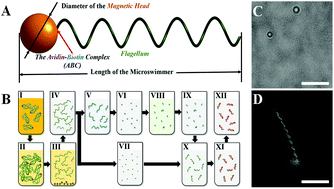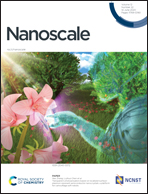Flagellar nanorobot with kinetic behavior investigation and 3D motion†
Abstract
Wirelessly controlled nanorobots have the potential to perform highly precise maneuvers within complex in vitro and in vivo environments. Flagellar nanorobots will be useful in a variety of biomedical applications, however, to date there has been little effort to investigate essential kinetic behavior changes related to the geometric properties of the nanorobot and effects imparted to it by nearby boundaries. Flagellar nanorobots are composed of an avidin-coated magnetic nanoparticle head (MH) and a single biotin-tipped repolymerized flagellum that are driven by a wirelessly generated rotating magnetic field. Nanorobots with different MHs and flagellar lengths were manually guided to perform complex swimming trajectories under both bright-field and fluorescence microscopy visualizations. The experimental results show that rotational frequency, handedness of rotation direction, MH size, flagellar length, and distance to the bottom boundary significantly affect the kinematics of the nanorobot. The results reported herein summarize fundamental research that will be used for the design specifications necessary for optimizing the application of helical nanorobotic devices for use in delivery of therapeutic and imaging agents. Additionally, robotic nanoswimmers were successfully navigated and tracked in 3D using quantitative defocusing, which will significantly improve the efficiency, function, and application of the flagellar nanorobot.



 Please wait while we load your content...
Please wait while we load your content...